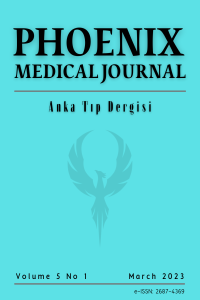Nadir ve Atipik Bulgularla Seyreden Bir Smith-Magenis Sendromu Vakası
Smith-Magenis Sendromu, Mikropenis, İnmemiş Testis, RAI-1 geni, Mikrodizin Analizi
Rare and Atypical Findings in Smith-Magenis Syndrome: A Case Report
___
- 1. Elsea SH, Girirajan S. Smith–Magenis syndrome. European Journal of Human Genetics. 2008; 16(4), 412–421.
- 2. Falco M, Amabile S, Acquaviva F. RAI1 gene mutations: mechanisms of Smith-Magenis syndrome. Appl Clin Genet. 2017; 10:85-94.
- 3. Greenberg F, Guzzetta V, Montes de Oca-Luna R, Magenis RE, Smith AC, Richter SF et al. Molecular analysis of the Smith-Magenis syndrome: a possible contiguous-gene syndrome associated with del(17)(p11.2). Am J Hum Genet. 1991; 49(6):1207-18.
- 4. Chen L, Mullegama SV, Alaimo JT, Elsea SH. Smith-Magenis syndrome and its circadian influence on development, behavior, and obesity - own experience. Dev Period Med. 2015; 19(2):149-56. Review.
- 5. Smith AC, Dykens E, Greenberg F. Sleep disturbance in Smith-Magenis syndrome (del 17 p11.2). Am J Med Genet. 1998; 81(2):186- 191.
- 6. Vlangos CN, Yim DK, Elsea SH. Refinement of the Smith-Magenis syndrome critical region to approximately 950kb and assessment of 17p11.2 deletions. Are all deletions created equally? Mol Genet Metab. 2003; 79(2):134-41.
- 7. Boudreau EA, Johnson KP, Jackman AR, Blancato J, Huizing M, Bendavid C et al. Review of disrupted sleep patterns in Smith-Magenis syndrome and normal melatonin secretion in a patient with an atypical interstitial 17p11.2 deletion. Am J Med Genet A. 2009; 149A (7):1382-91.
- 8. Smith ACM, Boyd KE, Brennan C, Charles J, Elsea SH, Finucane BM, Foster R, Gropman A, Girirajan S, Haas-Givler B. Smith-Magenis Syndrome. 2001 Oct 22 [updated 2019 Sep 5]. In: Adam MP, Ardinger HH, Pagon RA, Wallace SE, Bean LJH, Stephens K, Amemiya A, editors. GeneReviews® [Internet]. Seattle (WA): University of Washington, Seattle; 1993-2019.
- 9. Nijim Y, Adawi A, Bisharat B, Bowirrat A. First Case Report of Smith-Magenis Syndrome (SMS) Among the Arab Community in Nazareth: View and Overview. Medicine (Baltimore). 2016 Jan;95(3):e2362.
- 10. Gropman, A. L., Elsea, S., Duncan, W. C., & Smith, A. C. (2007). New developments in Smith-Magenis syndrome (del 17p11.2). Current Opinion in Neurology, 20(2), 125–134.
- 11. Doherty ES, Lacbawan FL. 2q37 Microdeletion Syndrome. 2007 May 3 [Updated 2013 Jan 31]. In: Adam MP, Ardinger HH, Pagon RA, et al., editors. GeneReviews® [Internet]. Seattle (WA): University of Washington, Seattle; 1993-2019.
- 12. Perkins T, Rosenberg JM, Le Coz C, et al. Smith-Magenis Syndrome Patients Often Display Antibody Deficiency but Not Other Immune Pathologies. J Allergy Clin Immunol Pract. 2017;5(5):1344–1350.e3.
- 13. Medina-Gomez C, Kemp JP, Dimou NL, Kreiner E, Chesi A, Zemel BS et al. Bivariate genome-wide association meta-analysis of pediatric musculoskeletal traits reveals pleiotropic effects at the SREBF1/TOM1L2 locus. Nat Commun. 2017; 25;8(1):121.
- Yayın Aralığı: Yılda 3 Sayı
- Başlangıç: 2019
- Yayıncı: İbrahim İKİZCELİ
İdiyopatik Makula Deliği Tedavisinde 25 Gauge Pars Plana Vitrektomi Sonuçlarımız
Coronavirüs Nedir, Nasıl Korunabiliriz?
Acil Servise Kuduz Riskiyle Başvuran Hastaların Demografik Özelliklerinin Analizi
Türkan DEVECİ, Mehmet Oğuzhan AY, Akkan AVCİ, Müge GÜLEN, Salim SATAR
Canlı Kuryeler ve Görüntüleme: Olgu Sunumu
Onur TUTAR, Yonca Senem AKDENİZ, İbrahim İKİZCELİ, Türkan İKİZCELİ
Acil Serviste Nadir Bir Tanı – Dolikoektazi
Yonca Senem AKDENİZ, Gökcan AMAN, Mehmet GÜN
Kronik Esrar Kullanımı Olan Hastada Wellens Sendromu
Mustafa ÖZTÜRK, Rana AKKOYUN, Sunay YILDIRIM, Selman YENİOCAK
Hipertansif Acillerin Yönetimi ve Tedavisi
Tarık ALAY, Yonca Senem AKDENİZ
Acil Servise Başvuran İskemik İnme ve Geçici İskemik Atak Hastalarının Değerlendirilmesi
Serpil SOYUDOĞRU, Yonca Senem AKDENİZ, Afşın İPEKCİ, İbrahim İKİZCELİ
Anadolu’da Bir Şehir; Çorum’da Acil Servisde Aile İçi Şiddetin Ortaya Konması
Nadir ve Atipik Bulgularla Seyreden Bir Smith-Magenis Sendromu Vakası
